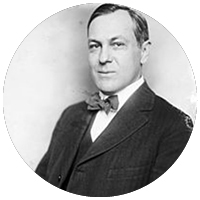Features
A Portrait of Frederick “Fritz” G. Lanham
Published: January 13, 2021

Craig Stone Phillips 66 Company Houston, Texas, USA

Frederick Garland Lanham, Weatherford, Texas, USA
Frederick “Fritz” Garland Lanham of Weatherford, Texas, USA, is most known for his influence in the field of U.S. federal trademark law, the primary statute which bears his name, the “Lanham Act.” As a U.S. congressman, he championed the proposed legislation for 18 years until its adoption in 1946.
This year marks the 75th anniversary of this landmark legislation that governs the way trademarks and the legal rights of brand owners are uniformly protected under U.S. federal law. Simply put, Rep. Lanham was the leading advocate for the primary federal rights granted to brand owners and which benefit consumers every day.
The Lanham Act governs federal trademark registration, trademark infringement, trademark dilution, and false advertising in the United States. It enables consumers to confidently identify and differentiate between the hundreds of thousands of brands inundating the marketplace every day and to distinguish, with confidence, the nature and quality associated with the products and services we enjoy in our daily lives.
President Harry Truman signed the Act into law on July 5, 1946, and it took effect one year later, on July 5, 1947. Since its enactment, the Lanham Act has been cited by the U.S. Supreme Court in 57 decisions, and by federal and state courts across the country in more than 34,000 decisions.
This landmark piece of legislation enables consumers to confidently identify and differentiate between the hundreds of thousands of brands inundating the marketplace every day.
Before Mr. Lanham’s illustrious career as a U.S. congressman, he earned a B.A. from the University of Texas at Austin (UT) in 1900 and pursued graduate studies in law at the university until 1903. Although he never completed his law degree, Mr. Lanham was admitted to the Texas Bar in 1909, where he practiced in his hometown of Weatherford, Texas, USA. While at the university, Mr. Lanham became the first editor of The Texan, the school newspaper (now known as The Daily Texan) beginning in the fall of 1900.
In his first editorial, Mr. Lanham said the paper’s goal should be, “ultimately to please the student body.” While he acknowledged there were always two sides to every issue, he said The Texan should present only “the proper one.” Mr. Lanham wrote most frequently about the extracurricular topic that was most important to the university community—football. His reports included comments on every single play of each game, and he was known to critique the performances of each athlete. Although never good enough for the varsity team, Mr. Lanham was also a football player for the university. Off the field, his contributions were significant and included raising money for the Longhorn band’s first uniforms and revenue for the then-struggling University Athletic Association by authoring and producing plays and musical comedies performed at Austin’s Hancock Opera House. He also founded the Alcalde, the university’s alumni magazine.
In addition to this strong affiliation with UT, Mr. Lanham had deep ties to Texas history and politics. He was one of eight children of Samuel and Sara Lanham. His father served as the 22nd governor of the State of Texas and as a U.S. congressman from Texas. It was Mr. Lanham’s father who, while serving as Texas governor, convinced his son to take a year off prior to attending law school and serve as the governor’s personal secretary. This was Mr. Lanham’s introduction into the world of politics.
Since its enactment, the Lanham Act has been cited by the U.S. Supreme Court in 57 decisions and by federal and state courts across the country in more than 34,000 decisions.
In 1919, Mr. Lanham won a special election to Congress in Texas’s 12th congressional district (encompassing Fort Worth and Weatherford), succeeding fellow Democrat James Clifton Wilson, who resigned to accept a federal judgeship on the U.S. District Court for the Northern District of Texas. Mr. Lanham would go on to serve in Congress from 1919–1947. While in Congress, he served on several committees, including the Committee on Patents. He was a strong supporter of President Franklin D. Roosevelt and the New Deal. Congressman Lanham was reelected 13 times and served with distinction until his retirement in 1946.
Although Mr. Lanham never practiced trademark law, he became convinced during his time in Congress that the nation’s trademark laws needed to be modernized and expanded to provide stronger protection for brand owners. Rep. Lanham introduced HR 9041 in 1938, and over the next eight years he worked tirelessly to accomplish what was called the “Herculean task” of convincing Congress to broaden trademark protection through passage of what we now call the Lanham Act—an effort that was strongly opposed by the Antitrust Division of the Department of Justice.
The Lanham Act, which resulted in the repeal of the previously enacted acts of 1881 (narrowly protecting federal trademark registrations of foreign nations and Indian tribes) and the acts of 1905 and 1920 (prohibiting willful or intentional misrepresentation of trademarks but often considered too restrictive to be useful), is named in honor of its champion, Congressman Lanham.
[T]o help celebrate his contributions and honor his legacy, a group of Texas lawyers recently founded a new nonprofit known as the Texas Intellectual Property Law Foundation.
This federal statute (now codified under Title 15 of the United States Code) has served as the primary vehicle by which brand owners have a federal right to more broadly and effectively protect their trademarks. It also sets out the actions and remedies available for registered and unregistered trademark infringement.
In addition, the statute prohibits (1) the importation of goods that infringe federally registered trademarks; (2) the use of false designations of origin; and (3) the dilution of famous marks. Most significantly, the Lanham Act allowed for additional causes of action for owners of unregistered marks. In addition, the Act eliminated the requirement of “willfulness” or “intent to deceive” as necessary elements to prevail in a trademark action under federal law.
Shortly after his seminal accomplishment, Rep. Lanham retired from Congress and returned to Texas to live out his life doing the things he loved to do—reading, writing poetry, preaching on Sundays as a lay minister in the Methodist Church, and entertaining children with magic tricks. His congressional papers are maintained at the Dolph Briscoe Center for American History at the University of Texas. He also continued to work in Washington as a lobbyist for the National Patent Council.
Mr. Lanham died on July 31, 1965, at Seton Hospital in Austin, Texas. He is buried at City Greenwood Cemetery in Weatherford.
Mr. Lanham was truly loved by those who knew him as a consummate gentleman, a man of uncompromising standards and ethics, and a gifted politician. After his death, the Fort Worth Star-Telegram, in a lead editorial entitled “Lanham, Gentleman of the Golden Age,” wrote: “Classically educated, courtly, urbane and eloquent, Mr. Lanham was so much the gentleman that many thought this a handicap to his political career. It never appeared to be. He was a highly effective legislator and had a rare influence with his colleagues, who knew him to be unswervingly a man of his word.” The federal building in Fort Worth now bears his name to honor Congressman Lanham’s remarkable influence and legacy.
This year we take time to reflect on Rep. Lanham’s legacy and his great effort and support of this important milestone in trademark history and recognize the role Mr. Lanham had on directly shaping federal trademark law.
Although the landscape in 2021 certainly has changed since the 1940s and Mr. Lanham could never have imagined how the economy and commerce would be impacted by the Internet and other technological advances, it is a great testament to the elected officials who crafted a strong backbone of laws that still serve us well today in our globally connected and digitally driven economic universe.
The anniversary will be officially celebrated at the State Bar of Texas Annual Meeting (June 17–18, 2021) in Fort Worth.
Inspired by the 75th anniversary of the Lanham Act to help celebrate Rep. Lanham’s contributions and honor his legacy, a group of Texas lawyers recently founded a new nonprofit known as the Texas Intellectual Property Law Foundation. The aim of the Foundation is to undertake initiatives and activities not permitted by the traditional section under the current rules and procedures of the Texas Bar (submitting amicus briefs, advocating for legislative changes, and awarding diversity scholarships). Members of the new Foundation are comprised of past presidents and current officers and council members of the State Bar of Texas Intellectual Property Law Section.
To mark the 75th anniversary, the Foundation will host a celebration at the State Bar of Texas Annual Meeting from June 17–18 in Fort Worth. The guests include various dignitaries and officials from the state as well as David Gooder, the Commissioner of Trademarks at the U.S. Patent and Trademark Office (USPTO), who will be delivering the keynote address.
Other tributes are in the works. The IP Law Section and Foundation are also collaborating with the USPTO to help fund and create museum-quality displays featuring Mr. Lanham. The displays will debut at the Bar’s Annual Meeting and will then embark on a traveling roadshow to the USPTO’s regional offices before ultimately being permanently exhibited at the National Inventors Hall of Fame® in Alexandria, Virginia, USA. Additionally, a book authored by Joe Cleveland, which celebrates Mr. Lanham’s life and accomplishments, has been licensed to the Foundation on a royalty-free basis. Proceeds from book sales will be used to fund scholarships for those demonstrating a keen interest in a career in intellectual property. Diversity is expected to be a key factor when awarding the scholarships.
Read more about Mr. Lanham in the Texas State Historical Association’s Handbook of Texas.
See the federal trademark statute “Lanham Act.”
For more on a recent major update to U.S. trademark law, the Trademark Modernization Act signed into law on December 30, 2020, see the INTA Bulletin article.
Editor’s Note: The content of this article includes quotes and remarks delivered by William “Bill” Barber, Senior Partner of Pirkey Barber, at the Congressional anniversary celebration of the Lanham Act from 2016, and a publication authored by Louis T. Pirkey, “Fritz Lanham—Portrait of a Remarkable Man” published in 1996 in honor of the 50th Anniversary of the Lanham Act. All individuals above are proud graduates of UT and lifetime members of the Texas Exes alumni association.
Although every effort has been made to verify the accuracy of this article, readers are urged to check independently on matters of specific concern or interest.
© 2021 International Trademark Association